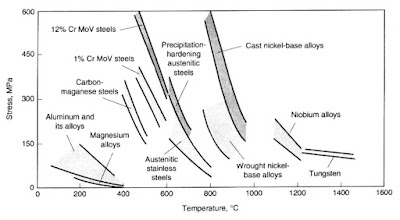18/11/2019
The super-alloys family is composed by those alloys which fundamental constituting chemical element is Ni or Co. These elements, along with the addition of variable amounts of other elements, such as Cr, Nb, Ti, Al, Hf, Cu configure a material with a high resistance to corrosion, to deformation and to fracture in elevated temperatures.
Due to this combination of characteristics, these alloys are mainly used in applications like plane engines, turbines for gas generation or machinery for the transport of corrosive gases or liquids at high temperatures.
 |
| Figure 1: Breaking charge of different alloys depending on temperature. (Source: “Heat Resistant Materials”, ASM International Special edition) |
Nevertheless, from a metallurgical point of view, these high added value alloys are the greatest unknown. The reason behind this might rely on their limited market and the little research that has been performed on them to the date. These alloys get manufactured in multiple ways; the components with directional solidification and monocrystal components are the ones associated to the most innovative processes. In these cases, the orientation and the size of the crystal are the main aspects that bring very specific properties for these components to be used in very particular applications.
However, there is another range of parts manufactured with superalloys that work in lower temperatures, under very isolated efforts, or with great continuous requirements in very aggressive corrosive environments. Some parts created with these alloys also must be welded to form more complex subsets. In these circumstances, their manufacturing processes are mainly associated to molten parts, resulting in micro-structures of irregular grain and with a very significant segregation level. Therefore, fractures happen in welding processes. To palliate this negative effect, components designers usually oversize the thickness of the parts and manufacturers and assemblers have difficulties for their recovery.
Faced with this problem, the most logical solution seems to reduce the size of grain and segregations but putting it into practice is not that simple. A first approach to the issue leads to think that with using a more conductive sand and/or localized coolers in the molds may help obtain good results. Nonetheless, these alloys have a very poor thermal conductivity and these techniques have shown very limited success.
Consequently, the problem must be attacked from the inside and, for this purpose, a liquid-state nucleating effect is needed. This effect, started inside the metal, propitiates the generation of a greater amount of crystals and lets less room for the segregation of the elements that constitute the alloy.
One of the opportunities identified is the use of inoculants, which are chemical products that are applied in some alloys, such as iron foundry, to achieve the nucleation of some phases. The use of inoculants implies two fundamental phases: the manufacturing of the inoculant, with the right composition and granulometry, and its posterior process of addition. In this second step both the amount and the inoculation moment must be considered because, depending on the time elapsed, a vanishing effect can happen so the effect of the inoculant gets weakened. The results of the inoculation are unequivocal and grain size reduction is achieved without observing any inclusions in the sample.
Working in an analogous way to inoculants but based on a localized subcooling (and not in the generation of particles as germination nucleus), micro-chills can also be used. By means of adding these in the proper amounts and composition, a germination of the nucleuses of the same alloy is produced locally when the annexed area gets cooled due to the fusion of the nucleus introduced. The results are similar to those of the use of inoculants and the effect can be observed in the grain size reduction of the superalloy manufactured by means of any of the aforementioned methods
 |
| Figure 2: Grain size in superalloy IN718 |
Anyway, these are not the only methods that can be used to modify the microstructure of these superalloys. With the help of thermodynamic and thermokinetics modelizers the processes of dissolution and phases precipitation can be simulated. This graphic representation of the evolution of phases makes it possible to develop more effective heat treatments to achieve a better microstructure depending on the step of the process or the expected application conditions the service life of the component.
 |
| Figure 3: Modelling of the forming and dissolution of phases in IN718 superalloy |
With no doubt, altering the microstructure of superalloys that are casted by means of traditional methods represents new improvement opportunities and new potential applications for this range of advanced materials.


